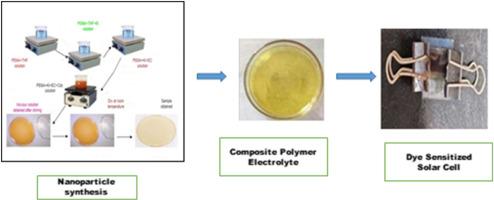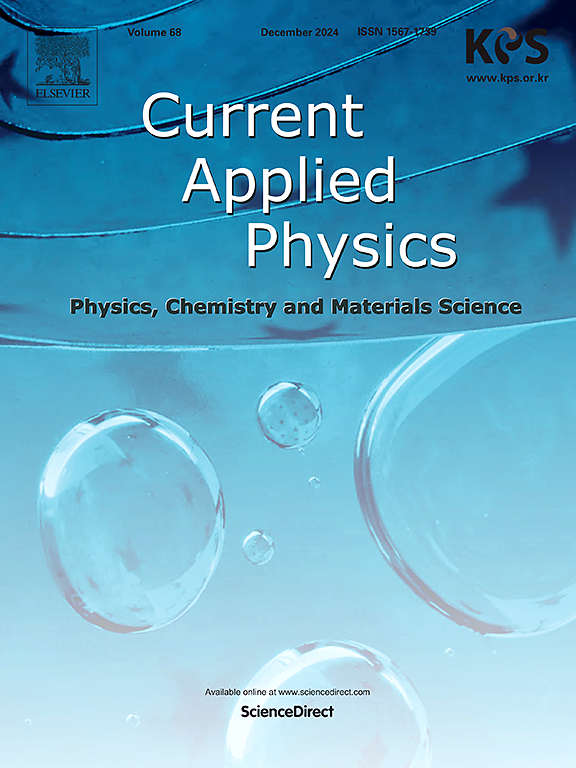硫化镉对聚(甲基丙烯酸乙酯)(PEMA)电解质纳米复合材料的影响及其在染料敏化太阳能电池(DSSC)中的应用
IF 2.4
4区 物理与天体物理
Q3 MATERIALS SCIENCE, MULTIDISCIPLINARY
引用次数: 0
摘要
通过加入纳米硫化镉(CdS)材料,对基于聚(甲基丙烯酸乙酯)(PEMA)的聚合物复合电解质的结构和离子电导特性进行了详细研究。当采用溶液浇铸技术时,添加了 40% 重量的碘化钾(KI)和 60% 重量的碳酸乙烯酯(EC)的 PEMA 具有最高的离子电导率(4.65 × 10-5 S/cm)。硫化镉(CdS)与 PEMA + KI 40% wt.+ 60% 重量比的样品中加入硫化镉(CdS),以获得导电率最高的样品。硫化镉(CdS)的重量百分比为 7%时,离子电导率最高,达到 2.65×10-3S/cm。使用扫描电子显微镜检查了导电样品的形态,使用傅立叶变换红外(FTIR)技术研究了其非晶态和晶体结构,并比较了 PEMA 聚合物 + KI 盐 + EC 增塑剂和 PEMA 聚合物 + KI 盐 + EC 增塑剂 + CdS 纳米颗粒的最高导电性样品的傅立叶变换红外'波长'。X 射线衍射(XRD)被用来确定聚合物复合电解质最大导电性样品的无定形性质。差示扫描量热法(DSC)分析用于确定聚合物复合电解质最大导电性样品的玻璃化转变温度(Tg)。采用刮刀法开发了染料敏化太阳能电池(DSSC),并观察到在一束阳光下,能量转换效率为 2.09%,参数填充因子为 79.77%。本文章由计算机程序翻译,如有差异,请以英文原文为准。

Effect of cadmium sulphide on poly (ethyl methacrylate) (PEMA) based electrolyte nanocomposite and its application in dye sensitized solar cell (DSSC)
The detail study of structural and ionic conductivity characterization of Poly (ethyl methacrylate) (PEMA) based polymer composite electrolyte were modified by the incorporation of Cadmium sulphide (CdS) nanomaterial. PEMA in addition with 40 % wt. potassium iodide (KI) and ethylene carbonate (EC) having 60 % wt., has the highest ionic conductivity of 4.65 × 10−5 S/cm when employed the solution casting technique. Cadmium Sulphide (CdS) was incorporated with PEMA + KI 40 % wt. + EC 60 % wt. sample to get maximum conductivity sample. The highest ionic conductivity 2.65×10−3S/cm, was attained at 7 % weight percentage of Cadmium sulphide (CdS). The conductive sample's morphology was examined using SEM, its amorphicity and crystalline structure was investigated using Fourier transform infrared (FTIR) technique, and FTIR 'wavenumbers of the maximum conductive sample of PEMA polymer + KI salt + EC plastizer and PEMA polymer + KI salt + EC plastizer + CdS nanoparticles were compared. X-ray diffraction (XRD) was used to identify the amorphous nature of the maximum conductive sample of polymer composite electrolyte. Differential scanning calorimetry (DSC) analysis was used to find out the glass transition (Tg) temperature of maximum conducting sample of polymer composite. The doctor blade method was employed to develop the dye sensitized solar cell (DSSC), and it had been observed that, under one sunlight situation, the energy conversion efficiency was 2.09 %, having parameters fill factor was 79.77 %.
求助全文
通过发布文献求助,成功后即可免费获取论文全文。
去求助
来源期刊

Current Applied Physics
物理-材料科学:综合
CiteScore
4.80
自引率
0.00%
发文量
213
审稿时长
33 days
期刊介绍:
Current Applied Physics (Curr. Appl. Phys.) is a monthly published international journal covering all the fields of applied science investigating the physics of the advanced materials for future applications.
Other areas covered: Experimental and theoretical aspects of advanced materials and devices dealing with synthesis or structural chemistry, physical and electronic properties, photonics, engineering applications, and uniquely pertinent measurement or analytical techniques.
Current Applied Physics, published since 2001, covers physics, chemistry and materials science, including bio-materials, with their engineering aspects. It is a truly interdisciplinary journal opening a forum for scientists of all related fields, a unique point of the journal discriminating it from other worldwide and/or Pacific Rim applied physics journals.
Regular research papers, letters and review articles with contents meeting the scope of the journal will be considered for publication after peer review.
The Journal is owned by the Korean Physical Society.
 求助内容:
求助内容: 应助结果提醒方式:
应助结果提醒方式:


